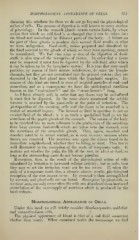Page 521 - My FlipBook
P. 521
MORPHOLOGICAL APPEARANCE OF CELLS. 531
claiming this attribute for them we do not go beyond the physiological
action of cells. The process of digestion is well known to every student
of physiology. In the stomach glands secrete certain fluids, by whose
action that which we call food is so chang-ed that it can be taken into
the blood and assimilated by different parts of the body. A failure on
the part of these glands to produce their normal fluid results in what
we term indigestion. Foocl-stuflfs, unless prepared and dissolved by
the fluid secreted by the glands of which we have been speaking, cannot
be assimilated. We find that what is true of the digestion of food-
stuffs is also true of the resorption of tissues. In order that a tissue
may be removed it must first be digested by the cell-fluid, after which
it can be taken up by the lymphatic system. It is true that very small
particles, by reason of their minute subdivision, do enter the lymph-
channels, but they are not assimilated into the general system ; they are
deposited in the first gland into which the lymphatic empties. In-
stances of this kind are found in cases of respired particles of coal- and
stone-dust, and as a consequence we have the pathological condition
known as the " coal-miner's " and the " stone-hewer's " lung.
As I have already said, in order that any tissue may be assimilated
it must first be digested. In the cases above mentioned the soluble
ferment is secreted by the giant-cells at the point of irritation. The
juxtaposition of the secreting cells and the tissue to be resorbed is a
matter of essential import. The ferment or fluid in question is not an
exuded fluid of the blood ; it is as truly a specialized fluid as are the
secretions of the peptic glands of the stomach. The nature of the body
to be resorbed has no more influence in the production of the secretions
than have various food-stuffs which are taken into the stomach over
the secretions of the stomachic glands. Then, again, resorbed and
resorber must be in actual contact, as is seen in every instance where
tissues are removed. The secretion acts upon the tissues found in its
immediate neighborhood, whether they be living or dead. This fact is
well illustrated in the resorption of the roots of temporary teeth. It
matters not whether the pulp, the life of the root, be alive or dead, so
long as the surrounding j^arts do not become purulent.
Resorption, then, is the result of the physiological action of cells
stimulated by irritation to increased cellular activity ; but in order that
they may so act the irritation must not be too severe. If, when the
pulp of a temporary tooth dies, a chronic abscess results, physiological
resorption of the root cannot occur. Its removal is then accomplished
by necrosis, and gicmt-cells are not found. Resorption by giant-cells, as
we have seen, can only occur when the cells are stinmlated to an increased
assimilation of the over-supply of nutrition which is produced by the
local irritant.
Morphological Appearance of Cells.
Under this head we will briefly consider blood-corpuscles, epithelial
and connective-tissue cells.
The physical appearance of blood is that of a red fluid somewhat
thicker than water. When examined under the microscope we find


